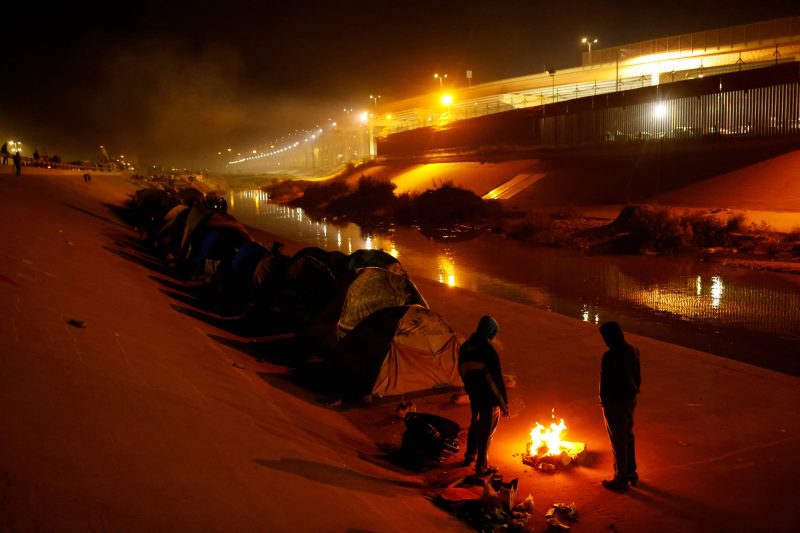Chief Justice John G. Roberts Jr. on Monday temporarily left in place a pandemic-era policy that allows the government to quickly expel millions of migrants from U.S. borders and had been set to expire Wednesday.
Roberts’s brief order was an “administrative stay” that allows the court to consider an emergency application from Republican state officials who want the Title 42 policy to remain while litigation continues.
The action follows a ruling by a federal appeals court in Washington last week that paved the way for the Biden administration to terminate the policy on Dec. 21, and to once again allow migrants who cross the southern border illegally to seek asylum without the risk of being expelled.
Roberts, who reviews emergency requests from the U.S. Court of Appeals for the D.C. Circuit, gave the Department of Homeland Security and immigrant advocates until 5 p.m. Tuesday to respond to the request from Republican state officials, which was submitted on Monday. The call for responses typically means that the full court will be involved in deciding the matter — either before Wednesday or sometime after.
More than 2.4 million people have been expelled, mostly from the southern border, since the Trump administration first imposed the emergency order in March 2020, saying it was intended to prevent the spread of the coronavirus.
“Getting rid of Title 42 will recklessly and needlessly endanger more Americans and migrants by exacerbating the catastrophe that is occurring at our southern border,” Arizona Attorney General Mark Brnovich (R) said in a statement announcing the emergency request to the Supreme Court.
U.S. District Judge Emmet G. Sullivan in the District of Columbia ruled last month that the policy should end and asylum proceedings should be restored. He was acting on a request from immigration advocates, who said there was no evidence that Title 42 protected public health and that it placed migrants — who otherwise would be able to seek protection in the United States — in extreme danger.
The Biden administration has agreed Title 42 should cease. But the case comes as the Department of Homeland Security is struggling to deal with an influx of migrants that officials anticipate will increase in the coming weeks if the administration is allowed to eliminate the policy.
Republican officials from states including Arizona, Texas and Virginia had asked the D.C. Circuit to intervene in the case and to block the Biden administration’s plans to terminate the policy. The officials said a large increase in migrants crossing the border would burden their states with added costs for law enforcement and to provide services such as health care.
A three-judge panel refused the states’ request, saying it was filed too late and noting that the lawsuit challenging Title 42 had been pending for nearly two years.
“The inordinate and unexplained untimeliness of the States’ motion to intervene on appeal weighs decisively against intervention,” said the unsigned order from a panel that included judges nominated by presidents of both parties. Judge Florence Pan is a Biden nominee; Judge Justin Walker a Trump pick; and Judge Patricia Millett, an Obama nominee.
Title 42 has allowed U.S. officials to regulate migration by expelling migrants, often within minutes of their arrival. Formal deportation hearings, in contrast, can take months or years in backlogged immigration courts, and once immigrants are in the country, it can be difficult for authorities to find and remove them. About 69,000 of the estimated 11 million undocumented immigrants in the country were deported last year, federal data show.
In vacating the policy, Sullivan in the District of Columbia wrote that federal officials knew Title 42 “would likely expel migrants to locations with a ‘high probability’ of ‘persecution, torture, violent assaults, or rape’” — but they implemented the program nevertheless.
“It is unreasonable for the CDC to assume that it can ignore the consequences of any actions it chooses to take in the pursuit of fulfilling its goals,” Sullivan wrote. “It is undisputed that the impact on migrants was indeed dire.”
The brief order from Roberts on Monday puts Sullivan’s ruling on hold but does not predict how the full court will eventually rule.
Republican state officials asked the high court to intervene because of the case’s “enormous national importance.” In addition to asking Roberts to keep the policy in place, the officials asked the court to quickly consider the merits of the case this term. The filing notes that homeland security officials are seeking more than $3 billion in emergency funding to handle the anticipated influx and that there has been a surge of migrants approaching the border in the lead up to Dec. 21.
“No one reasonably disputes that the failure to grant a stay will cause a crisis of unprecedented proportions at the border,’ the filing says. “The idea that the States will not suffer substantial irreparable harm as a result of the imminent catastrophe that a termination of Title 42 will occasion is therefore fanciful.”
Lee Gelernt, an ACLU attorney and lead counsel in the Title 42 challenge, said the court should deny the request. “The States are transparently and dangerously seeking to use a public health measure for border management,” he said.
White House Press Secretary Karine Jean-Pierre said Monday that the administration is “surging” personnel and supplies to the border and urged Congress to provide more funding.
Homeland Security officials have warned repeatedly that lifting Title 42 will not end immigration enforcement. Anyone ineligible for asylum could be prosecuted for the crime of crossing the border illegally.
“It would be wrong to think that the border is open,” Jean-Pierre said at the briefing. “It is not open. And I just want to be very, very clear about that.”
Officials said earlier this year that they are preparing for as many as 18,000 arrivals a day, more than double current numbers, if Title 42 ends. But a federal official speaking on the condition of anonymity to discuss internal figures said last week that officials are estimating that the daily influx would range from 9,000 to 14,000.
El Paso Mayor Oscar Leeser issued a disaster declaration on Saturday in anticipation of Title 42 ending. The region is one of the busiest stretches on the U.S.-Mexico border, with thousands of migrants lining up in hopes of being allowed to stay.
Leeser, a Democrat, expressed concern that more migrants could end up on the streets in near-freezing nighttime temperatures, and said the city’s shelter and transportation networks are straining to keep up with the influx.
“There are significant public safety and security concerns related to the wave of migration, including but not limited to the risk of injury or loss of life with migrants in El Paso streets with little or no resources, “ Leeser said in the declaration.
Even with Title 42 in place, the U.S. government has been granting exceptions to more migrants. U.S. Customs and Border Protection’s El Paso sector, which runs from west Texas into New Mexico, took 53,284 migrants into custody in October, and expelled one third, federal records show.








